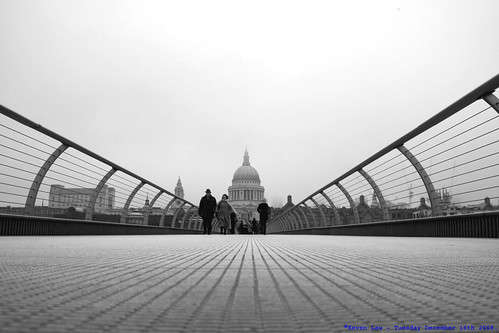Source link : https://londontimenews.info/2025/01/06/gallery/coming-out-of-the-fog/

Highest Explore Position #253 ~ On December 19th 2008.
Millenium Bridge / St Paul’s Cathedral, London, England – Tuesday December 16th 2008.
Click here to see the Larger image
Click here to see My most interesting images
Unlike yesterday when we have sun and blue sky’s here in London, Tuesday it was dull grey and foggy…so as it was pretty much devoid of colour, I’ve made this image Black n White..:O))
Today’s weather was also dull and grey again, although it wasn’t foggy…I have one day left at work before Christmas…so I hope the weather will be kind after tomorrow, as I will be off for two weeks…:O)))
I hope you are all having an awesome Thursday…:O)))
From Wikipedia, the free encyclopedia ~ The London Millennium Footbridge is a pedestrian-only steel suspension bridge crossing the River Thames in London, England, linking Bankside with the City. It is located between Southwark Bridge (downstream) and Blackfriars Bridge (upstream). With construction beginning in 1998, it is owned and maintained by the Bridge House Estates a charitable trust overseen by the City of London Corporation.
Londoners nicknamed the bridge the Wobbly Bridge after crowds of pedestrians felt an unexpected swaying motion on the first two days after the bridge opened. The bridge was closed and modified, and further modifications eliminated the “wobble” entirely.
The southern end of the bridge is near Globe Theatre, the Bankside Gallery and Tate Modern, the north end next to the City of London School below St Paul’s Cathedral. The bridge alignment is such that a clear view of St Paul’s south facade is presented from across the river, framed by the bridge supports, thus providing a scenic view of the cathedral.
The nearest London Underground station is Blackfriars.
Design ~ The design of the bridge was the subject of a competition organised in 1996 by Southwark council. The winning entry was an innovative “blade of light” effort from Arup, Foster and Partners and Sir Anthony Caro. Due to height restrictions, and to improve the view, the bridge’s suspension design had the supporting cables below the deck level, giving a very shallow profile. The bridge has two river piers and is made of three main sections of 81 metres (266 ft), 144 metres (472 ft) and 108 metres (354 ft) (North to South) with a total structure length of 325 metres (1,066 ft); the aluminium deck is 4 metres (13 ft) wide. The eight suspension cables are tensioned to pull with a force of 2,000 tons against the piers set into each bank — enough to support a working load of 5,000 people on the bridge at one time.
Construction ~ The bridge from St Paul’s CathedralConstruction began in late 1998 with the main works beginning on 28 April 1999 by Monberg Thorsen and Sir Robert McAlpine.[1] The bridge was completed at a cost of £18.2m (£2.2m over budget) and opened on 10 June 2000 (2 months late). Unexpected lateral vibration (resonant structural response) caused the bridge to be closed on 12 June for modifications.
Attempts were made to limit the number of people crossing the bridge: this led to long queues, but dampened neither public enthusiasm for what was something of a white-knuckle ride, nor the vibrations themselves. The closure of the bridge only three days after opening attracted public criticism, as another high-profile British millennium project suffered an embarrassing setback, akin to how many saw the Millennium Dome.
Further modifications to the bridge successfully eliminated the “wobble,” which has not recurred since the bridge reopened in February 2002.
The bridge was temporarily closed on 18 January 2007, during the Kyrill storm due to strong winds and a risk of pedestrians being blown off the bridge.
Resonance ~ The bridge from St Paul’s after opening: long queues formed as attempts were made to limit vibrationsThe bridge’s movements were caused by a ‘positive feedback’ phenomenon, known as Synchronous Lateral Excitation. The natural sway motion of people walking caused small sideways oscillations in the bridge, which in turn caused people on the bridge to sway in step, increasing the amplitude of the bridge oscillations and continually reinforcing the effect.
The bridge opened on an exceptionally fine day, and it was included on the route of a major charity walk. On the day of opening the bridge was crossed by 90,000 people, with up to 2,000 on the bridge at any one time.
Resonant vibrational modes due to vertical loads (such as trains, traffic, pedestrians) and wind loads are well understood in bridge design. In the case of the Millennium Bridge, because the lateral motion caused the pedestrians loading the bridge to directly participate with the bridge, the vibrational modes had not been anticipated by the designers (Arup).
Posted by law_keven on 2008-12-18 16:20:07
Tagged: , London , England , Millenium Bridge , St Pauls Cathedral , fog , Black n White , Bridge , foggy , Explore 500 , Cubism , Black & White Photos
The post Coming out of the Fog…. first appeared on London.
Author : london
Publish date : 2025-01-06 13:52:11
Copyright for syndicated content belongs to the linked Source.